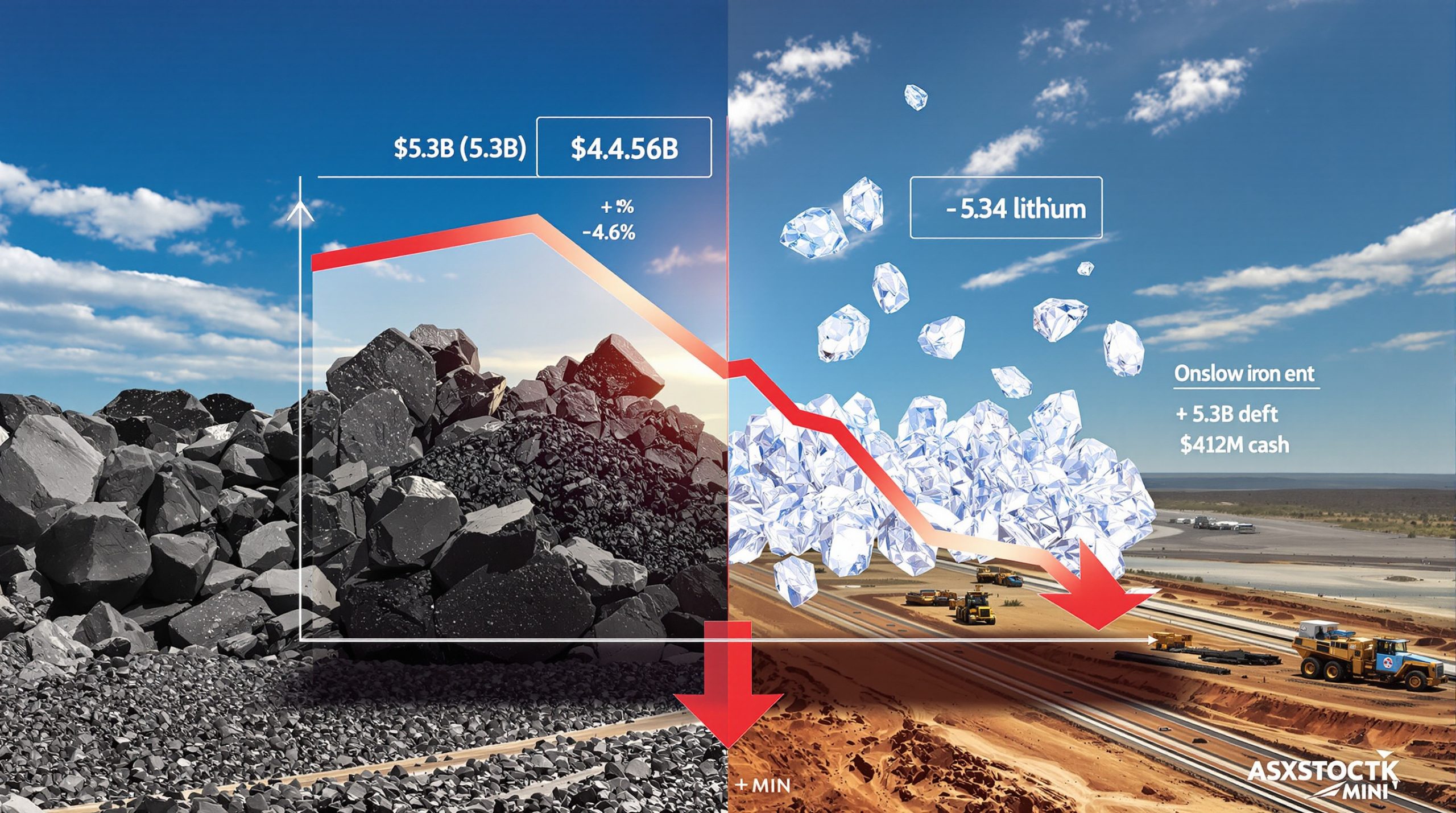What Factors Drove the South32 Shares Revenue Decline?
South32 Limited recently reported its financial results for the 2025 fiscal year, revealing an 8% year-over-year decline in underlying revenue to US$7.61 billion. This significant downturn has triggered investor concern, with shares dropping from $2.91 to $2.77, representing a 4.8% intraday decline following the announcement. The broader market context adds perspective, as the ASX 200 remained essentially flat during the same trading session, highlighting South32's underperformance relative to the market.
How Has South32's Revenue Performance Changed Year-Over-Year?
The company's financial metrics tell a nuanced story beyond the headline revenue decline. While top-line figures retreated, several key performance indicators actually improved, suggesting operational enhancements despite revenue challenges.
| Metric | FY24 | FY25 | % Change |
|---|---|---|---|
| Underlying Revenue (US$ bn) | 8.27 | 7.61 | -8% |
| EBITDA (US$ bn) | 1.81 | 1.93 | +7% |
| EBITDA Margin (%) | 22.8 | 26.3 | +3.5 pts |
| Cost Base (US$ bn) | 6.02 | 5.44 | -9.6% |
| Free Cash Flow (US$ m) | -80 | +272 | N/A |
| Final Dividend (US cents/share) | 3.1 | 2.6 | -16% |
The 8% revenue contraction stands in stark contrast to the company's improved profitability metrics. South32's EBITDA grew by 7% year-over-year to reach US$1.93 billion, while EBITDA margins expanded by 3.5 percentage points to 26.3%. This margin expansion demonstrates that despite selling less, the company managed to extract more value from each dollar of revenue.
Over the past 12 months, South32 shares have fallen approximately 10% excluding dividends, substantially underperforming the relatively stable ASX 200 Index. This prolonged underperformance suggests the market remains cautious about the company's growth trajectory despite operational improvements.
What Were the Primary Causes Behind the Revenue Downturn?
The revenue decline can be attributed to several key factors, with asset divestment playing the most significant role. In August 2024, South32 completed the sale of its Illawarra Metallurgical Coal (IMC) business for US$938 million, strategically divesting from coal operations but simultaneously removing a substantial revenue stream from its portfolio.
This strategic divestment forms part of South32's broader portfolio transformation, reducing exposure to thermal coal and focusing on metals essential for the critical minerals energy transition. However, in the short term, this has created a revenue gap that even rising commodity prices couldn't fill.
Natural disasters further compounded the company's challenges. Tropical Cyclone Megan significantly disrupted operations at Australia Manganese, one of the company's key assets. These weather-related disruptions required substantial recovery efforts, with the company noting that Australia Manganese has since completed its operational recovery plan.
What's particularly notable is that these negative factors outweighed what would typically be positive catalysts. Management reported that higher average commodity prices and increased sales volumes across other parts of the business weren't sufficient to offset the reduced revenue from divested assets and weather-related disruptions. This underscores the magnitude of the impact from the IMC divestment.
How Did Operational Strategies Influence the Financial Position?
South32's operational strategies delivered meaningful improvements to the company's cost structure and cash flow profile. The company achieved a remarkable US$579 million reduction in its cost base, bringing it down to US$5.44 billion in FY2025. This 9.6% decrease resulted primarily from the completed sale of IMC and focused cost management initiatives across remaining operations.
Perhaps most impressively, free cash flow swung from a US$80 million outflow in FY2024 to a positive US$272 million in FY2025, representing a US$352 million improvement. This cash flow reversal demonstrates South32's ability to generate liquidity even amid revenue challenges, providing financial flexibility for future investments and shareholder returns.
CEO Graham Kerr highlighted operational milestones that supported these improvements: "Worsley Alumina securing environmental approvals for new bauxite mining areas, and Australia Manganese completing its operational recovery plan following the impacts of Tropical Cyclone Megan."
These achievements demonstrate the company's ability to navigate regulatory challenges and recover from natural disasters, two critical capabilities in the mining sector. The environmental approvals at Worsley Alumina are particularly significant as they secure future mining areas, addressing potential production constraints that might otherwise have emerged.
How Are Divisional and Commodity Shifts Affecting South32's Outlook?
South32's performance increasingly reflects its strategic shift toward metals that support global decarbonization efforts. This pivot represents both opportunity and challenge for the diversified miner as it navigates changing global demand patterns and energy supply constraints.
In What Ways Are Commodity Trends Impacting Results?
The company reported impressive growth in production volumes for key metals aligned with energy transition needs. Copper production increased by 20% year-over-year, while aluminum output grew 6%. These metals are fundamental to electrification, renewable energy infrastructure, and energy-efficient technologies.
CEO Graham Kerr emphasized this strategic alignment, stating: "We increased our production of commodities critical to the global energy transition, delivering annual production growth of 20% in copper and 6% in aluminum."
This production growth in strategic metals partially offset revenue losses from divested coal assets. The company's pivot toward energy transition metals positions it to benefit from increasing global demand for these materials, particularly as governments worldwide accelerate their critical minerals strategy. Furthermore, the latest copper and uranium insights suggest continued strong demand for these metals.
However, geopolitical and energy market factors create significant operational challenges. Most notably, the company faces electricity supply constraints at its Mozal Aluminum operations. CEO Kerr provided concerning forward guidance regarding this operation: "At Mozal Aluminum, despite engaging with stakeholders for several years, we do not have confidence that the smelter will secure sufficient and affordable electricity supply beyond March 2026, when the current agreement expires."
This energy security issue has forced South32 to limit investment in Mozal Aluminum, with management currently expecting to place the smelter on care and maintenance in March 2026. This situation illustrates how energy supply challenges can significantly impact operational planning and asset utilization in energy-intensive mining operations.
What Synergies or Risks Have Emerged After Portfolio Changes?
South32's strategic portfolio changes have enhanced operational resilience while creating a more streamlined business model. The divestment of non-core assets like Illawarra Metallurgical Coal has improved the company's cost profile and focused operations on higher-margin activities.
The company has demonstrated adaptation to climate and weather disruptions, particularly in its Australia Manganese operations following Tropical Cyclone Megan. This operational flexibility is increasingly valuable as extreme weather events become more common in mining regions.
However, significant risks remain, particularly regarding power price volatility and electricity supply security. The situation at Mozal Aluminum highlights how energy supply constraints can threaten the viability of energy-intensive processing operations. This risk extends beyond a single asset, as similar energy challenges could potentially impact other smelting operations in South32's portfolio.
The company's mitigation efforts include limiting further investment in at-risk operations and preparing for potential care and maintenance scenarios. While these approaches minimize financial exposure, they also limit growth potential in affected assets.
How Has Shareholder Value Been Affected by South32's Recent Results?
The market's immediate reaction to South32's financial results reveals investor concerns about the company's growth trajectory, despite operational improvements and enhanced profitability metrics.
What's the Current Share Price Trend and Market Sentiment?
Following the release of FY2025 results, South32's share price dropped significantly from $2.91 to $2.77, representing a 4.8% intraday decline. This negative reaction occurred despite improvements in EBITDA, margins, and cash flow, suggesting investors focused primarily on the revenue decline rather than profitability improvements.
Over the longer term, South32 shares revenue decline has reached approximately 10% over the past year, excluding dividends. This performance significantly underperforms the ASX 200 Index, which remained relatively stable during the same period. The persistent share price weakness indicates ongoing investor skepticism about South32's growth prospects.
Market sentiment appears particularly concerned about the company's revenue outlook following the divestment of Illawarra Metallurgical Coal and the potential care and maintenance status for Mozal Aluminum. These changes create uncertainty about future revenue streams, despite the strategic rationale behind the decisions.
Investors appear to be weighing the short-term revenue impact against long-term strategic benefits, with current share price performance suggesting skepticism about the timing and magnitude of future returns from South32's transformed portfolio.
How Does the Dividend Compare Year on Year?
South32 declared a fully franked final ordinary dividend of US 2.6 cents per share for FY2025, representing a 16% reduction from the previous year's final payout. This dividend decrease aligns with the revenue decline but contrasts with the improved EBITDA and cash flow metrics.
The lower dividend reflects management's desire to balance shareholder returns with prudent capital management as the company navigates its portfolio transformation. By maintaining a more conservative payout ratio, South32 preserves financial flexibility for potential future investments in growth projects, particularly in copper and aluminum production.
For income-focused investors, the reduced dividend represents a disappointing outcome. However, the fully franked status of the dividend provides tax advantages for Australian investors, partially offsetting the lower payment amount. The company's improved free cash flow position suggests potential for future dividend growth if operational improvements continue.
What Can Investors Expect Looking Ahead?
South32's future prospects depend on its ability to execute its strategic vision while navigating commodity market volatility and operational challenges. Management's focus on critical minerals positions the company to benefit from energy transition trends, but execution risks remain.
How Is Management Positioning for the Future?
Management has clearly articulated a strategy focused on operational excellence, portfolio refinement, and growth in critical minerals. CEO Graham Kerr emphasized, "We are focused on maintaining our strong operating momentum and capitalizing on our transformed portfolio to deliver growth and returns for shareholders."
The company's 20% growth in copper production and 6% expansion in aluminum output demonstrate successful execution of its strategy to increase exposure to energy transition metals. These production increases position South32 to benefit from growing demand for materials essential to global decarbonization efforts.
However, challenges remain, particularly regarding energy supply security for smelting operations. The expected care and maintenance status for Mozal Aluminum from March 2026 highlights the operational risks associated with energy-intensive processing assets in regions with unreliable or expensive electricity supply.
Management is preparing for these challenges by limiting investment in at-risk operations while pursuing growth in more secure operational environments. This balanced approach aims to mitigate downside risks while positioning for upside potential in favorable commodity markets.
Step-by-Step: Key Watchpoints for Investors
Investors monitoring South32 should focus on several key metrics and developments to assess the company's progress:
-
Cost base trends and operational efficiency – Watch for continued cost discipline and efficiency improvements across remaining operations. The US$579 million cost reduction in FY2025 sets a high benchmark for future optimization efforts.
-
Copper and aluminum production growth – Monitor quarterly production reports for evidence of continued expansion in these critical minerals. Sustained production growth will be essential to offset revenue lost from divested assets.
-
Asset transition progress – Track management updates on portfolio optimization, including potential further divestments and strategic investments in growth projects. The successful execution of these transitions will determine long-term growth potential.
-
Mozal Aluminum developments – Pay close attention to updates regarding electricity supply negotiations and operational planning for this asset beyond March 2026. Any positive developments could significantly impact the company's medium-term outlook.
-
Free cash flow generation – Assess the sustainability of positive free cash flow as an indicator of operational health and dividend sustainability. Continued cash flow improvement would support both investment capacity and shareholder returns.
With ongoing industry consolidation trends and sustainability transformation insights shaping the mining sector, South32's strategic positioning within these broader market movements will be crucial to monitor.
Frequently Asked Questions (FAQ)
Why did South32's revenue fall despite commodity price gains?
South32's revenue declined primarily due to the divestment of Illawarra Metallurgical Coal, which removed a significant revenue stream from the company's portfolio. Additionally, operational disruptions at Australia Manganese caused by Tropical Cyclone Megan further reduced production and sales volumes. These negative factors outweighed the positive impact of higher average commodity prices and increased volumes in other parts of the business.
How did South32 offset its revenue pressure?
The company implemented comprehensive cost reduction initiatives, achieving a US$579 million decrease in its cost base to US$5.44 billion. This 9.6% reduction helped improve operating margins despite lower revenue. Additionally, South32 enhanced production in high-demand commodities like copper (up 20%) and aluminum (up 6%), partially offsetting revenue losses from divested assets. These efforts collectively improved EBITDA by 7% and transformed a US$80 million cash outflow into a positive US$272 million free cash flow.
What does the drop in dividend signal?
The 16% reduction in South32's final dividend to US 2.6 cents per share reflects management's balanced approach to capital allocation during portfolio transformation. Rather than maintaining previous dividend levels, which might constrain financial flexibility, the company has chosen to preserve capital for potential growth investments while still providing shareholder returns. This suggests management confidence in long-term prospects but acknowledgment of near-term revenue challenges as the portfolio continues to evolve.
Conclusion
South32's revenue decline in FY2025 reflects a company in strategic transition rather than operational deterioration. The 8% revenue decrease resulted primarily from strategic portfolio decisions, particularly the divestment of Illawarra Metallurgical Coal, rather than fundamental business weakness.
The company's operational performance actually strengthened during this period, with improved EBITDA, margins, and free cash flow demonstrating enhanced efficiency and value creation from remaining assets. Production growth in strategic metals like copper (up 20%) and aluminum (up 6%) positions the company to benefit from increasing demand for materials essential to global energy transition efforts.
However, challenges remain, particularly regarding energy security for smelting operations. The expected care and maintenance status for Mozal Aluminum from March 2026 highlights the operational risks associated with energy-intensive processing assets in regions with uncertain electricity supply.
For investors, South32's immediate outlook may continue to feature revenue volatility as the company completes its portfolio transformation. However, the long-term strategic positioning in critical minerals, improved cost structure, and enhanced cash flow generation capacity create potential for future value creation if management successfully executes its vision.
Monitoring key operational metrics, especially cost control, production growth in strategic metals, and successful navigation of energy challenges, will provide valuable insights into South32's progress toward its strategic objectives and long-term value creation potential.
Ready to Spot the Next Major ASX Discovery?
Discovery Alert's proprietary Discovery IQ model instantly notifies investors of significant ASX mineral discoveries, turning complex data into actionable insights for traders and long-term investors alike. Understand why historic discoveries can generate substantial returns by visiting Discovery Alert's dedicated discoveries page and position yourself ahead of the market.




